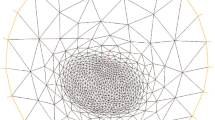The paper considers some modern problems arising in developing parallel algorithms for solving large systems of linear algebraic equations with sparse matrices occurring in mathematical modeling of real-life processes and phenomena on a multiprocessor computer system (MCS). Two main requirements to methods and technologies under consideration are fast convergence of iterations and scalable parallelism, which are intrinsically contradictory and need a special investigation. The paper analyzes main trends is developing preconditioned iterative methods in Krylov’s subspaces based on algebraic domain decomposition and principles of their program implementation on a heterogeneous MCS with hierarchical memory structure.
Similar content being viewed by others
References
S. C. Eisenstat, H. C. Elman, and M. H. Schultz, “Variational iterative methods for nonsymmetric systems of linear equations,” SIAM J. Numer. Anal., 20, No. 3, 345–357 (1983).
J. Y. Yuan, G. H. Golub, R. J. Plemmons, and W. A. Cecilio, “Semi-conjugate direction methods for real positive definite systems,” BIT, 44, No. 1, 189–207 (2004).
V. P. Il’in and E. A. Itzkovich, “Semi-conjugate direction methods with dynamic preconditioning,” Sib. Zh. Industr. Mat., 10, No. 4, 41–54 (2007).
A. Ruhe, “Rational Krylov sequence methods for eigenvalue computation,” Linear Algebra Appl., 58, 391–405 (1984).
V. Druskin, L. Knizhnerman, and V. Simoncini, “Analysis of the rational Krylov subspace and ADI methods for solving the Lyapunov equation,” SIAM J. Numer. Anal., 49, No. 5, 1875–1898 (2011).
M. van Gijzen and P. Sonneveld, “Algorithm 913: An elegant IDR(s) variant that efficiently exploits biorthogonality properties,” ACM Trans. Math. Software, 38, No. 1 (2011), Article 5.
M. B. van Gijzen, G. L. G. Sleijpen, and J.-P. M. Zemke, “Flexible and multi-shift induced dimension reduction algorithms for solving large sparse linear systems,” Numer. Linear Algebra Appl., 22, 1–25 (2015).
A. Chapman and Y. Saad, “Deflated and augmented Krylov subspace techniques,” Numer. Linear Algebra Appl., 4, No. 1, 43–66 (1997).
Y. L. Gurieva and V. P. Il’in, “Some parallel methods and technologies of domain decomposition,” Zap. Nauchn. Semin. POMI, 428, 89–106 (2014).
I. V. Oseledets and E. E. Tyrtyshnikov, “Breaking the curse of dimensionality. Or how to use SVD in many dimensions,” SIAM J. Sci. Comput., 31, Iss. 5, 3744–3759 (2009).
W. Hackbusch, Hierarchische Matrizen: Algorithmen and Analysis, Springer (2009).
R. Bridson and C. Greif, “A multipreconditioned conjugate gradient algorithm,” SIAM J. Matrix Anal. Appl., 27, No. 4, 1056–1068 (2006).
C. Greif, T. Rees, and D. B. Szyld, MPGMRES: a generalized minimum residual method with multiple preconditioners. Tech. Rep. 11-12-23, Department of Mathematics, Temple University (2011).
C. Greif, T. Rees, and D. B. Szyld, “Additive Schwarz with variable weights,” Lect. Notes Comput. Sci. Eng., 98, 779–787 (2014).
Y. Saad, Iterative Methods for Sparse Linear Systems, 2nd ed. Society for Industrial and Applied Mathematics (2003).
V. Dolean, P. Jolivet, and F. Nataf, “An introduction to domain decomposition methods: algorithms, theory and parallel implementation,” https://hal.archives-ouvertes.fr/cel-01100932.v4
A. Toselli and O. Widlund, Domain Decomposition Methods – Algorithms and Theory (Springer Ser. Comput. Math., 34), Springer (2005).
M. T. Chu, R. E. Funderlic, and G. H. Golub, “A rank-one reduction formula and its application to matrix factorization,” SIAM Rev., 37, 512–530 (1995).
L. Yu. Kolotilina, “Eigenvalue bounds and inequalities using vector aggregation of matrices,” Linear Algebra Appl., 271, 139–167 (1998).
O. Dubois, M. J. Gander, A. St.-Cyr, S. Loisel, and D. Szyld, “The optimized Schwarz method with a coarse grid correction,” SIAM J. Sci. Comp., 34, No. 1, 421–458 (2012).
Y. Efendiev, J. Galvis, R. Lazarov, and J. Willems, “Robust domain decomposition preconditioners for abstract symmetric positive definite bilinear forms,” Esaim Math. Model. Numer. Anal., 46, No. 5, 1175-1199 (2012).
D. S. Butyugin, Y. L. Gurieva, V. P. Il’in, D. V. Perevozkin, A. V. Petukhov, and I. N. Skopin, “Functionality and technologies of algebraic solvers in the KRYLOV library,” Vestn. YuUrGU, 2, No. 3, 92–105 (2013).
URL: http://www.ddm.org
CCA: The Common Component Architecture Forum. www.cca-forum.org/.
Author information
Authors and Affiliations
Corresponding author
Additional information
Translated from Zapiski Nauchnykh Seminarov POMI, Vol. 439, 2015, pp. 112–127.
Rights and permissions
About this article
Cite this article
Il’in, V.P. Problems of Parallel Solution of Large Systems of Linear Algebraic Equations. J Math Sci 216, 795–804 (2016). https://doi.org/10.1007/s10958-016-2945-4
Received:
Published:
Issue Date:
DOI: https://doi.org/10.1007/s10958-016-2945-4




